2012 Honda Civic Reviews
You'll find all our 2012 Honda Civic reviews right here. 2012 Honda Civic prices range from for the Civic to for the Civic Hybrid.
Our reviews offer detailed analysis of the 's features, design, practicality, fuel consumption, engine and transmission, safety, ownership and what it's like to drive.
The most recent reviews sit up the top of the page, but if you're looking for an older model year or shopping for a used car, scroll down to find Honda dating back as far as 1973.
Or, if you just want to read the latest news about the Honda Civic, you'll find it all here.
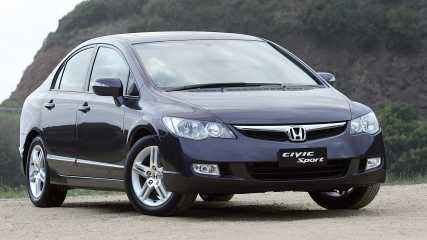
Used Honda Civic review: 2006-2012
Read the article
By Graham Smith · 04 Oct 2017
Honda has long had a reputation for building high quality prestige cars that are packed with technology. The front-wheel drive Civic is one of its most popular; it’s been a mainstay of the company’s range since it was introduced here in 1973, and the eighth generation model introduced in 2006 continued that

Used Honda Civic review: 2012-2016
Read the article
By Graham Smith · 03 Oct 2017
Honda has long used its involvement in motorsport to promote an image of prestige, quality, superior technology, and a sporty driving experience in all its models.

Used Honda Civic review: 2003-2015
Read the article
By Ewan Kennedy · 25 May 2016
Ewan Kennedy reviews the Honda Civic sedan and hatch between 2003 and 2015 as a used buy.

Honda Mean Mower vs BTCC Honda Civic
Read the article
By Mat Watson · 07 Nov 2013
The Honda Mean Mower has been specifically designed for racing drivers with very big lawns.
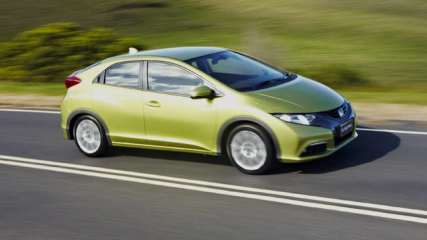
Honda Civic VTi-L 2012 review
Read the article
By Rebeccah Elley · 08 Nov 2012
Honda took a sales hit in early 2012 after the 2011 Thailand and Japanese natural disasters. The Japanese car giant hopes to gain lost ground with new models like the ninth generation Honda Civic five-door hatch that landed on our shores in June.The Civic four-door sedan comes from Thailand but the five-door hatch VTi-L tested here originates from the Swindon factory in the UK. Direct rivals include the Mazda3, Holden Cruze and Toyota Corolla all driving through a front-wheel four-cylinder.The base model VTi-S hatch starts from $22,650 (manual) and $24,950 (auto) and jumps up by $5000 to $29,990 for the top spec VTi-L, which is only available in the five speed auto with paddle shifters.The VTi-L gets a reversing camera, six CD player, seven-speaker stereo, subwoofer, 12V auxiliary sockets, Bluetooth and MP3 connectivity, dual air-conditioning, rain sensors, fuel consumption and temperature displays, steering wheel controls and heated front seats.Both variants are powered by a 1.8 litre four cylinder engine with 104kW of power and 174Nm of torque. The official combined fuel consumption for the auto is 6.5L/100km with 155g/km CO2 emissions. The Civic has an eco button for fuel saving that is suitable for start stop traffic. But you’ll want to turn the eco option off on open roads to get the car going.The exterior has a flat nose and a small grille with large slanting headlights. The shark fin antennae, hidden rear door handles and 17 inch alloy wheels (the base model gets 16 inch) give the hatch a sporty look. Honda designed the interior in a “cockpit style” with bucket seats that hug the driver and front passenger. The large speedometers add a racing feel. It also comes with a leather tilt and reach adjustable steering wheel that is a bit stiff. The leather seats in the VTi-L are attractive, while the base model only receives cheap looking fabric upholstery. Although there are five seats, the design is concentrated on the driver and front passenger’s comfort.The legroom in the backseats is tight, especially for 170cm plus passengers. The boot has a capacity of 390 litres and can be increased to 1120 litres with the rear seats down.The VTi-L receives a five-star ANCAP safety rating. Safety features include front, side and curtain airbags, vehicle stability assist, electronic brake force distribution, hill start assist, daytime running lights and front and rear fog lamps.We tested the Civic in its perfect environment – down narrow city streets, around sharp urban corners and through cramped cement parking spaces. And it did the job -- and then some.The five speed auto is easy to drive, requiring little effort from the driver (which may be boring for enthusiastic drivers). However, if you’re regularly commuting in heavy city traffic, you’ll appreciate the seamless gear changes. You can also push the eco button to help reduce your fuel consumption or turn it off for a sportier drive. The front vision is excellent largely due to the thin side pillars that don’t obstruct visibility. However rear vision is lacking, as the rear window is small and the back pillars are broad - the reversing camera assists with this issue.
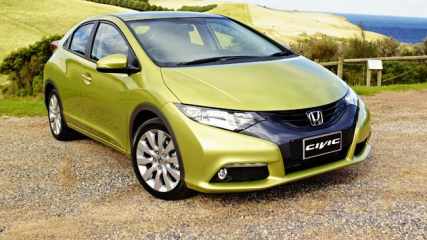
Honda Civic VTi-L 2012 Review
Read the article
By Chris Riley · 09 Oct 2012
We turn the spotlight on the car world's newest and brightest stars as we ask the questions to which you want the answers. But there's only one question that really needs answering -- would you buy one?What is it?Sporty five-door hatch version of Honda's best selling Civic. This one is built in the UK and costs more, but it's the one you'll want (leave the sedan for your mum). A new Type R is still a couple of years away.How much?The top of the line VT-L is $29,990 plus onroads. That's a whopping $6000 more than the VTi-L sedan, but you get a lot more for your money. The question is does it justify the difference?What are competitors?Mazda3 of course. Golf, Corolla, i30, Ford Focus and Holden's Cruze hatch to name a few.What's under the bonnet?1.8-lite four cylinder petrol engine. Produces 104kW of power and 174Nm of torque. It's a typical high-revving Honda engine that produces peak power at 6500 revs.How does it go?Lacks torque down low but once it's up and running sings like a bird. This can be deceiving to start with, but once you get the hang of it - it's all good.Is it economical?Takes premium unleaded, although it's the same engine as in the sedan which takes 91. This one is rated at 6.5 litres/100km, but we were getting 8.3 over a distance of 200km.Is it green?Gets 4 out of 5 stars from the Govt's Green Vehicle Guide (Prius sets the benchmark with 5). Produces 155g/km CO2.Is it safe?Scores a full 5 stars for crash safety from the ANCAP organisation, with six airbags and a full array of safety systems.Is it comfortable?Big thumps up. Seats cup your bum and offer good all around support without being too narrow. Car sits and rides well on the road, with a low centre of gravity.What's it like to drive?More dynamic than the sedan, but the suspension is not quite sporty enough when it counts. Like the multi-layered dash, but the computer screen is a waste of space (obviously waiting for satellite navigation). Trying to connect a mobile to the Bluetooth system can be challenging. If there's already a phone in the list, the trick is to say NO when it asks you wether you want to connect (not exactly intuitive)Is it value for money?Adds leather, heated front seats and dual zone climate air conditioning as well as premium audio. Gets bigger 17 inch wheels than the sedan too.Would we buy one?Hmmm. We'd probably hang out for the Type R, but given the choice between the hatch or the sedan, we'd take the hatch any day. Having said that there's more legroom in the rear of the sedan if that is important.Honda Civic VTi-L HatchPrice: from $29,990Warranty: 3 years/100,000kmResale: 54 per cent (Source: Glass's Guide)Service interval: 10,000km/6 monthsSafety rating: five starSpare: full-sizeEngine: 1.8-litre 16-valve four-cylinder, 104kW/174NmTransmission: 5-speed automatic; FWDBody: 4.3m (L); 1.8m (w); 1.5m (h)Weight: 1336kgThirst: 6.5L/100km, 155g/km CO2
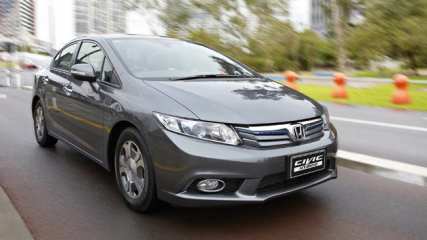
Honda Civic hybrid 2012 review: snapshot
Read the article
By Chris Riley · 11 Sep 2012
New technology comes at a price. And at $35,990, the hybrid version of the Civic is the most expensive by a country kilometre. That's $5000 more than the big ticket Sport (everyone likes a sport) but is the extra dosh worth it?It's powered by a combination of petrol and electric motors. The 1.5-litre four cylinder petrol engine is the primary source of power, assisted when necessary by a 17kW electric motor. Together, they produce 82kW of power at 5500 revs and 172Nm of torque between 1000 and 3500 revs.You can't plug it in. The battery recharges itself as you're going along. It's a new Lithium-Ion (Li-Ion) number that's lighter and more powerful than the nickel-metal hydrid (NiMH) battery that it replaces.Okay. In a word. There's enough there to satisfy undemanding drivers, but those buyers attracted by this car will be more interested in the technology and fuel consumption. The electric motor is designed to provide extra oomph during acceleration, but once you're up and running it cuts out as the system goes into charge mode.Drive is to the front wheels through a CVT continuously variable auto with its characteristic slur. To the inexperienced it might sound like the car is getting ready to blow up - but of course it's not.It uses a claimed 4.4 litres of fuel per 100km, slightly more than the Toyota Prius at 3.9 litres/100km. We've been getting 6.0 litres/100km.The Civic gets a full five stars for crash safety, with a long list of standard safety gear including six airbags, next-generation Vehicle Stability Assist (VSA), an anti-lock braking system (ABS) with Brake Assist and a new Motion Adaptive Electric Power Steering.It's a biggish small car that doesn't compromise on space. The seats are comfortable and the instruments all large and easy to read/use. The styling however is conservative, apart from the large digital speedo set above the other dials.The new Multi-Information Display (i-MID) is pretty cool, but unlike the Insight it misses out on satnav which is not available as an option either (different buyers we're told). Bluetooth is standard along with a USB Audio Interface for music players.The Prius of course and perhaps Honda's own cheaper Insight which is slightly smaller but boasts more goodies. You might also like to look at some of the incredibly fuel efficient diesels too. Electric cars at this stage are too expensive.

Honda Civic Hybrid 2012 review
Read the article
By Ewan Kennedy · 10 Sep 2012
Over a decade ago Honda brought the first ever mass-produced hybrid to Australia early in 2001. The Honda Insight was something out of the ordinary not only in its petrol-electric powertrain, but also in its radical styling.Sales have been slow for the Insight and its original near-$50,000 price tagin 2001 didn't help either - you could get into a mid-range Honda Civic for less than half of that. Honda quickly learned its lesson, so from 2004 began to import Civic hybrids rather than Insights. These have been moderately successful in the sales race over the years.In its strong push towards clean, green vehicles Honda now sells three hybrids in Australia: the Civic which is the subject of this test, the sporting CR-Z that picked up Wheels magazine’s car of the year award in 2011, and new Honda Insight. The latter being considerably more mainstream than the model that held that name 10 years back, though with a good dash of individuality.With the new model Civic hybrid for 2012 Honda is making a strong sales and marketing push. Amongst other methods it gave several motoring journalists the opportunity to live with a Civic hybrid for six months. We are now halfway through that period and are thoroughly enjoying the experience.The Civic hybrid loses a little boot space to house its battery but is better than many older generation hybrids. As the battery sits upright behind the rear seat here’s no fold-down facility to let you carry extra long items within the car. Interior space is fine for four adults, with room in the centre-rear for another without too much discomfort. Despite the sleek appearance of the body headroom in the Civic is fine.There’s a big emphasis on in-car entertainment and communication in the all-new Civic, with a screen in the right-centre of the dash devoted to phone, iPod and audio systems. These are controlled by buttons on the steering wheel to minimise - but obviously not eliminate - driver distraction.Owners of turbo-diesel cars, particularly those built in Europe, will point out that they can achieve similarly low fuel figures. However there’s a lot more to saving fuel when it comes to trimming the danger vehicles can cause to the air we breathe. Diesels put out significantly more CO2 than petrol-hybrids; as an example the Honda Civic hybrid is rated at 104 grams per kilometre in the Green Vehicle Guide, whereas diesel cars of this size typically push out 150 to 160 grams - a huge difference.Having covered almost 2000 km to date, we have found the Honda Civic hybrid using fuel in the range of 5.6 to 6.2 litres per hundred kilometres in commuter driving in town. This can be pulled down to the high fours on motorways while still flowing along easily with the traffic. A mixture of city and country driving usually had the fuel meter sitting in the low to mid fives.Major changes have been made to the electric motor and it is now powered by a lithium-ion battery in place of the nickel-metal-hydride of the previous model. This gives the Civic hybrid added torque off the line and it has plenty of performance for day-to-day driving. The petrol engine stops completely once the speed gets below about 10 km/h. It restarts as soon as you want to move off again.Because the ‘starter motor’ is the same one that helps drive the car, restarting is significantly smoother than that of a normal four-cylinder engine with a stop-start feature. The driver can select between economy and performance in several ways. As in many recent Hondas (not just hybrids) you can push an ‘Econ’ button to go for minimum fuel consumption.We found that using this can trim as much as five per cent off the routine fuel use. On the downside it really does deaden the feel of the engine and we weren’t all that keen on it. There’s also a Sports mode if you really wanting to pedal along hard and it certainly adds a fair bit of oomph to the performance. In reality we seldom felt any need for this as the hybrid isn’t that sort of car.
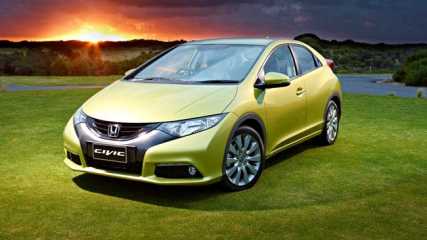
Honda Civic VTi-L hatch 2012 review
Read the article
By Stuart Martin · 31 Aug 2012
There are several sci-fi directions you could go when talking about the styling of the UK-sourced Honda Civic.Rather than get into some frivolous debate with chatroom dwellers around the globe, we'll just say this head turner from Honda is not short on looks.Keeping the aesthetic theme of the outgoing car but slicing the price could do wonders for the appeal in this price-conscious end of the market; we're in the Vti-L five-speed automatic hatch.The new UK-sourced hatch has a sharper price tag to the tune of $4000 over the outgoing model but its features list has not been culled to suit.The Civic Vti-L has automatic (halogen, not xenon) headlights, rain-sensing wipers, mirrors that are heated, power-adjustable and folding, front fog lights, LED tail lights and daytime running lights, a rear wiper for the expansive rear glass area, dual-zone climate control with rear vents, cruise control with speed limiter and three 12v outlets (two in-cabin, one in the boot) alloy pedals.And a height-adjustable driver's seat height, heated front seats, a trip computer, insulated windows, leather trim, a leather-wrapped steering wheel, splitfold rear seat, 17in alloys (although there's only a temporary spare) and a USB/AUX equipped seven-speaker premium sound system with Bluetooth phone and sound system link, but no satnav.The Civic gets a i-VTEC variable valve 1.8-litre engine, offering a meagre 104kW and 174Nm from 95RON fuel. The long-serving i-VTEC system picks between two cam profiles according to what demands are being placed on the engine to give it a bit more flexibility but the powerplant is definitely aiming for frugal fuel use - it claims a 10 per cent improvement over the outgoing car.The five-speed automatic gearbox is smooth and has a Sport mode and paddleshifts (it will hold a gear too) but you'd have thought six-speeds might have been forthcoming in a 2012 car. The driver can play with the economy mode of the car's throttle and climate control system - which also has blue (thirsty) to green (economical) dash lighting to encourage more frugal driving.Unlike some of the current Honda range, you can't call the new UK-built hatch boring, conservative or plain. Lower and wider than the outgoing model, the nose is aggressive and its flanks have some curvy lines to catch the light, but the rump is a little unwieldy. The high back probably works for the aerodynamic engineers and the rear visibility is improved by the extra window, but it's not as pretty a beasty from the rear. Most drivers (except perhaps the shorter pilot) will get plenty of forward vision through the large windscreen but rear-three quarter isn't as good - sensors teamed to the camera would make life a little less daunting in a close-quarter car park situation. The cargo space - which includes the area inhabited by the rear seats - is flexible and spacious.The Civic makes plenty of its solid construction and safety rank - it gets five stars from NCAP - and has dual front, front-side and full-length curtain airbags, stability and traction control, anti-lock brakes with brake assist and a tyre pressure deflation warning system.Apologies for borrowing from a weight loss company, but this car is light and easy to drive. But any expectation of spirited performance is unlikely to be met as its no firebrand masquerading as a shopping trolley. That's not really a criticism - for metro running and kid-carting, the Civic is a useful conveyance. The seating is comfortable and flexible, there's enough cabin space and storage for occupants to get comfy and stow their gear. The good-quality sound system's sub-woofer eats 10 litres of space from the boot, leaving 390 litres, but clever rear seats make the rear load space very flexible.The dash and instruments are mostly easy to use, although some prefer dials to digital readouts; shorter drivers may have trouble getting a good position to see all instruments and over bonnet at the same time given the steering wheel's location and the dashboard configuration.Night running revealed plenty of reflection from the instrument and infotainment display, perhaps a deeper cowling might fix that. The dashboard looks like it could display a satnav image but it's nowhere to be seen - unlike much of its competition. Steering assistance has rendered the helm beyond light and not over-run with road-feel - it isn't going to usurp the Honda sports cars of olde for feedback.Ride is firmer than expected - it did transmit small sharp bumps more than expected but general compliance on the larger ruts and bumps was acceptable. Some of the systems seem overly complex - the Bluetooth menu system is fiddly to set up - and despite being built in a right-hand drive market, the hatch has Euro traits like the handbrake and indicator set up for left-hand drive.

Used Honda Civic review: 1995-2012
Read the article
By Ewan Kennedy · 03 Aug 2012
Honda Civic began as a small car but increased in size over the years to become a small-medium by the period we are considering here.Because of the expansion in body size Honda also imports a smaller model, the Honda Jazz. Those who loved the smaller Civics of old may care to check out the Jazz. The Honda Civic has long had a reputation for build quality and reliability and this has lifted it a notch or two in the image stakes in Australia.Civic is a Japanese design in sedan format, with a fair bit of European input in the hatchback. The latter is built in England, the sedans in Japan or Thailand, the Civic petrol-electric hybrids are all made in Japan.Build quality doesn’t appear to be dependent on the country the Civic is manufactured in because the Japanese head office keeps a tight rein on the output of the factories. Interior room in the Honda Civic is good without being outstanding. There is space for four adults but in reality the rear seat is probably best left to children.Boot space is fine. Sedans are longer than hatches and most of this extra body size is put into a larger luggage area. There is some loss of boot space in the hybrid due to the installation of a large battery, but it’s better than many hybrids in this area.The Honda Civic is easy to drive and park thanks to light controls and good feel for the driver. These cars are popular with suburban users, but can be used on the open road, although bumpy secondary roads in the bush can cause a rough ride at times in older Civics as they have relatively short-travel in their suspension. Later models, from 2006, are better than the older ones.On smooth and moderate roads the Civic offers the sort of relaxed noise and vibration levels that are generally only found in cars from the next size class upwards. Engine sizes in the standard Civics are 1.6 litres and 1.7 litres in the older models; rising to 1.8 and even 2.0 litres in the current versions, introduced in 2012. The 2.0-litre engines are fitted to the sportier Civics and give plenty of performance.The semi-race Civic VTi-R, sold from 1996 until 1999, is very quick and is a delightful hot four. However, its engine only has a capacity of 1.6 litres and you have to work vigorously at the gearbox to keep it high in the rev range. If you’re not a keen driver you may find it frustrating and should perhaps avoid it. But if you do love pushing a car hard all the time then a VTi-R should definitely be on your short list.Five-speed manual gearboxes are standard in most models. Four-speed automatic transmissions are offered in all except the sporting Civic VTi-R. A five-speed auto is used in the eighth-generation Civics, launched at the start of 2006.The Civic Hybrid was introduced to Australia in early 2004 and is less extreme than previous Honda hybrids. As a result it’s more favourably priced. It has significantly lower pollutants from the exhaust as it runs a small 1.3-litre petrol engine, as well as an electric motor.The automatic fitted to the Civic Hybrid is a continuously variable transmission (CVT). Repairs and servicing can be relatively expensive. Spare parts also used to fall into that category, but Honda has worked hard with its parts network in recent years and things have improved considerably on the later Civics.Civic is reasonably simple mechanically so a good amateur mechanics can do a fair bit of the work themselves. Having a workshop manual at hand makes a lot of sense. Don’t attempt to carry out repairs to safety related items unless you have top class experience.Insurance costs are generally reasonable, with few companies making any real differentiation for the sportier versions of the Civic. Which is a surprise for such a little hotshot, it probably hasn’t sold in sufficient numbers to have come up on the radar of the insurance guys, let's hope it stays that way.Bodywork should be undamaged and free from rust. A Civic that has been poorly repaired after a smash may turn rusty later. Make sure the engine starts promptly and responds quickly and positively to the throttle. If possible arrange to start it when it’s cold after an overnight stop. Any engine that hesitates when revved suddenly should be treated with suspicion.A worn engine will smoke from the exhaust when it is driven hard after a period of idling. A conventional automatic transmission should be crisp in its changes and not hold onto any gear for too long. A continuously variable automatic transmission feels different in its operation so have an expert drive it if you are not confident it’s working correctly.The clutch pedal should be smooth in its operation. All manual gear changes should be light, positive and quiet. Problems will show up first on fast down changes, usually when going from third to second. Make sure the brakes pull the car up without any pulling to one side and that no one wheel locks while the others are still rolling freely.Look for Civics with a full service history as many belong to people who are very fussy about their cars.




